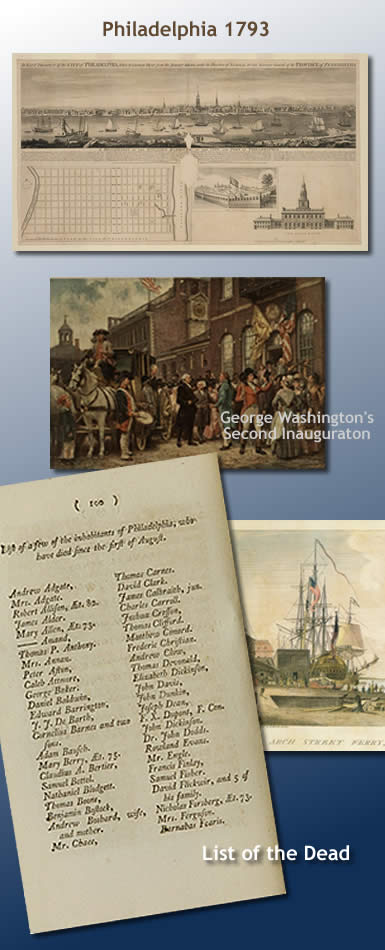Infectious Diseases Case of the Month 4th of July Special Edition |
||||||
 |
In 1793 Philadelphia was the largest city in the United States with a population of 51,000 and it was the country's temporary capital. George Washington was reinaugurated for his second term as President in March. Each action of the government of the fledgling nation was fraught with the precedent it might establish. In foreign policy there was preoccupation with the activities of France whose own revolution was considered by many as the logical continuation of the American Revolution. The excesses of the French Revolution and the relative weakness of the new American state persuaded President Washington to avoid entanglement in European affairs involving France. This was much to the dismay of many including prominent members of his own administration. The arrival in July of 2100 French refugees from the slave rebellion in Santo Domingo only aggravated the tensions. The summer of 1793 had been one of unrelenting heat and humidity. Sanitary measures in the city were essentially nonexistent - open sewers were particularly "ripe", and residents were apt to add to the noxious "soup" by tossing dead animals into the deep holes into which these sewers drained. To add to this in August was the stench of rotting coffee dumped on the Delaware River wharves after it had arrived spoiled from Santo Domingo. The eighty odd physicians of the city had witnessed a series of infectious diseases that year - mumps in January, jaw and mouth infections in February, scarlet fever in March, and influenza in July. In August they began to see the onset of an even more virulent febrile illness. This illness began with high fever and chills, headache, and a painful aching in the back, arms, and legs. These signs and symptoms lasted for about three days before patients appeared to temporarily improve only to relapse with high fever and the development of jaundice, bleeding of the gums, and black stale vomitus. Prostration and delirium presaged the death of patients which began to occur at an alarming pace. Initial cases appeared to cluster near the Delaware River wharves. Word of the epidemic spread. The mayor placed a notice in the newspaper that there was "great reason to apprehend that a dangerous infectious disorder" was loose in the city. Benjamin Rush, a signer of the Declaration of Independence and one of the country's most respected physicians, advised his friends to flee the city. Soon a mass panic and exodus of the residents of Philadelphia was in progress. When Secretary of Treasury Alexander Hamilton experienced a mild case of this illness, this exodus came to include many members of the Washington administration including Hamilton, Secretary of State Jefferson, and even George Washington himself (causing an early "constitutional crisis"). Physicians were uncertain as to the cause of this illness. Among the various possible causes were suggested jail fever, camp fever, military fever, and autumnal fever. For those physicians that remained in the city there was little to do for the victims to whom they ministered. Benjamin Rush administered a harsh regimen of bleeding and purgatives though other physicians strongly disputed this practice. When many of those who had the means had fled the city, the city became relatively deserted and quiet. Unfortunately, not all could flee, and illness and death continued. Paradoxically, the city also became a much cleaner place as a leading theory of the cause of this illness was that the unsanitary nature of urban life contributed to the development of the epidemic, and efforts were made to clean up the filth. Finally, as mysteriously as the illnesses had begun, the epidemic ebbed with the advent of cooler weather in the fall. Residents returned to the city but only after roughly five thousand (one tenth of the population) had succumbed to this fever. |
|||||
|
Answer and commentary will follow your submission. |
|||||